Latest news about Bitcoin and all cryptocurrencies. Your daily crypto news habit.
About a year ago, I was visiting Sri Lanka and had the pleasure of visiting Arthur C Clarke’s well-preserved office (you can read about my visit here if you like). Anyone who’s read that piece knows that I grew up as a big fan of Clarke’s science fiction, so it was a thrill to be there and see his books and office. He lived in Sri Lanka for 30 years before his passing in 2008.
This year, I’m unable to travel so far, but visiting my parents’ house in the midwest got me thinking about the times that I used to read Clarke’s science fiction books while growing up — imagining I was off with some crew on a “romp through the solar system”.
While there were some elements of Clarke’s books that are way out of our league even today (think star child or childhood’s end), there were always others that seemed like they weren’t too far away. So, this Christmas holiday, I wanted to write about a few things that Arthur C Clarke predicted in his science fiction and science-related works that have (mostly) come true (or will very soon!).
Science Fiction Turns Into Science
Of course, science fiction has always had a way of predicting the future, going all the way back to Jules Verne’s 1865 novel, From the Earth to the Moon. While he didn’t have it exactly right, Verne’s prediction that it would be the Americans who first got to the moon, firing off a giant gun (rockets didn’t exist) from somewhere in Florida, were pretty spot on. And who doesn’t know about the flip phone being a descendent of Star Trek, and today’s facetime and iWatch look a lot like Dick Tracy’s watch-phone, don’t they?
The difference between Clarke’s science fiction and much of these others was that he often put more thought into how these things could work and why they were the way they were — relying on them not just for convenience, but drawing on both scientific literature and scientific necessity. Unlike the Transporter in Star Trek, for example, which was created just for convenience (so that the producers wouldn’t have to pay for special effects of shuttles going to planets and back, which were costly), Clarke usually had some well thought out reason for the science fiction elements in his novels.
From ACC himself
Clarke himself once said that “trying to predict the future is a discouraging, hazardous occupation”, and some credit ACC (as he’s know in the science fiction world) with having predicted everything from the internet to email to google!
In this article, I’m going to stick to what ACC did best, write about outer space and aliens!
Now I’m not claiming that Clarke was necessarioly the first to think of all of these things — in fact, sometimes he was just the first to put them into popular science fiction even when a paper or a concept existed before.
So, without further ado, here are some predictions that have already (to different degrees, of course) come true:
1. The Gravity Assist Maneuver
In the novelization of 2001: A Space Odyssey, which was written concurrently with the movie (released in 1968), ACC had the Discovery go to one of Saturn’s moon’s (Iapetus) and not to Jupiter. In the movie, Stanley Kubrick (who was collaborating with ACC and wanted to use the latest images from NASA) decided to go with Jupiter as the destination because they had pictures from NASA about what Jupiter looked like. Kubrick was worried that since they didn’t have as many images of Saturn, the film might look dated once NASA got more accurate images.
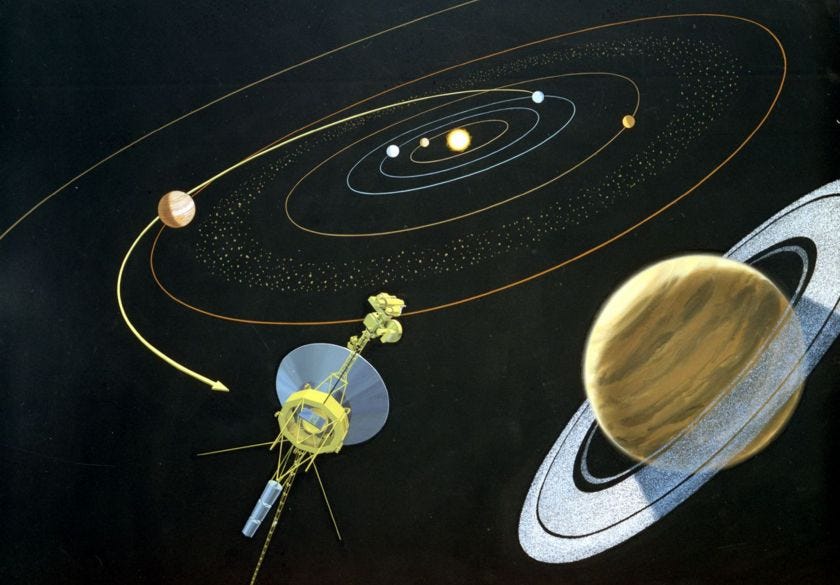 Just like in the novel 2001, the Voyager probes used Jupiter’s gravity to get to Saturn (src: the Planetary Society)
Just like in the novel 2001, the Voyager probes used Jupiter’s gravity to get to Saturn (src: the Planetary Society)
This is all a bit of history, but I recall reading the novelized version and it was the first time I had heard of the “gravity assist” maneuver. In the novel, the Discovery spaceship uses Jupiter’s gravity to speed itself up on the way to Saturn. While Jupiter is “only” 500 million kilometers away, Saturn can be almost a billion kilometers further away (depending on the position), even though we are used to them being close together . On average, the ringed planet is almost twice as far. This means that the ship didn’t have to carry as much fuel to get all the way to Saturn.
This idea of using planets to “assist” in slinging a spacecraft was actually used by NASA in many probes including the Mariner 10 and Voyager probes. In some cases the probes went inwards towards the sun and used Venus for gravity assist to slow down, while the Voyagers used Jupiter to speed up on their way to Saturn, just like in ACCs novel!
In another of his novels, Rendezvous with Rama (which we’ll talk more about in a minute), an alien spaceship built in an asteroid is using the Sun for a gravity assist on its interstellar mission! ACC wasn’t the first to think about this — the Soviets actually used the gravity of the moon for a flyby of a probe in 1959, but his use of it around a planet was the first time many science fiction readers like myself heard about it!
2. The Communication Satellite.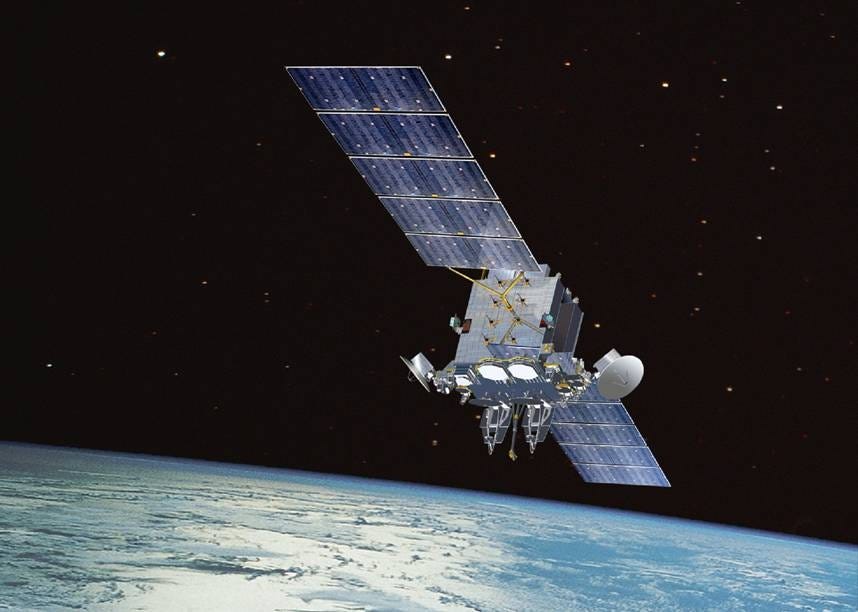 ACC proposed using a satellite in geosynchronour orbit for boucning off radio signals (src: Wikipedia)
ACC proposed using a satellite in geosynchronour orbit for boucning off radio signals (src: Wikipedia)
Arthur C Clarke, in an article for Wireless World in 1945, proposed the idea of a geostationary communications satellite, which was a satellite that stayed in the same position relative to the earth. Such a satellite, ACC proposed could be used to bounce radio signals off of and send radio signals all over the Earth. The editor of Wireless World changed his paper title to Extraterrestrial Relays.
According to many sources, the idea wasn’t taken seriously at the time as no one knew how to get a satellite into what became know as the “Clarke orbit”. 20 years later, in 1965, the first communications satellite was launched into the Clarke orbit, and today there are over 300 satellites on this orbit!
3. The asteroid from outside the solar system.
In 2017, a controversial object appeared in the night sky and was observed for a matter of weeks. It was determined to be the first known object that came from outside of our solar system. Its strange maneuvers and properties made scientists think it was an elongated (cigar-shaped) type of asteroid or comet or alien space probe — we couldn’t be sure which.
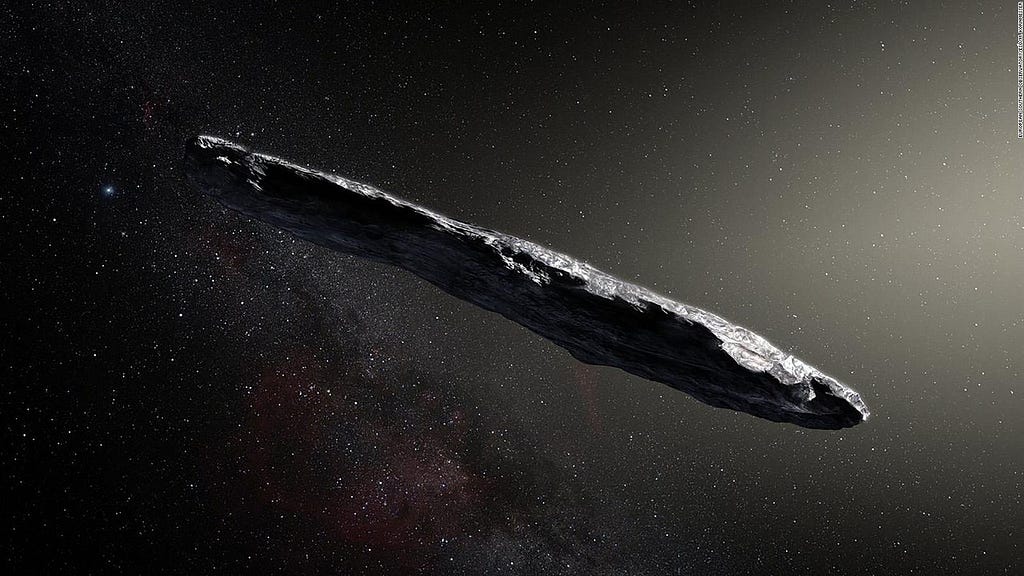 Conception of our first interstellar visitor , ‘Oumuamua (src: CNN)
Conception of our first interstellar visitor , ‘Oumuamua (src: CNN)
The scenario that astronomers found themselves in seemed eerily similar to ACC’s 1973 novel, Rendezvous with Rama. In the novel, an elongated asteroid was adapted into a space probe by an alien civilization, and wanders through our solar system, planning to use the sun as a gravity-assist maneuver to get where-ever it was going. The probe was abandoned in the book and its sequels by the alien civilization. Astronomers first proposed calling the asteroid discovered last year, which sure looked like it could be an asteroid steered by an alien civilization, Rama. In the end, the name ‘’Oumuamua was chosen (a good name which means “heavenly messenger” or “messenger from the past”), and of course scientists went ahead and stated confidently that there was nothing alien about the object.
It’s a year later and what do we know? The object did in fact swing around the sun, and its velocity increased in a way that wasn’t consistent with the asteroid or the comet hypothesis, leading some including Harvard astronomer Abraham Loeb, professor and chair of astronomy, and Shmuel Bialy, a postdoctoral scholar, at the Harvard Smithsonian Center for Astrophysics to speculate that it was an alien probe after all. It’s acceleration properties were more consistent with the properties of a light sail then either an asteroid or a comet!
So, while we don’t know what it was exactly, the best hypothesis we have that fits the data at present is that it was an alien probe going through our solar system swinging around the sun? Sounds familiar? Maybe it should be called Rama after all!
4. Building Ships in Orbit.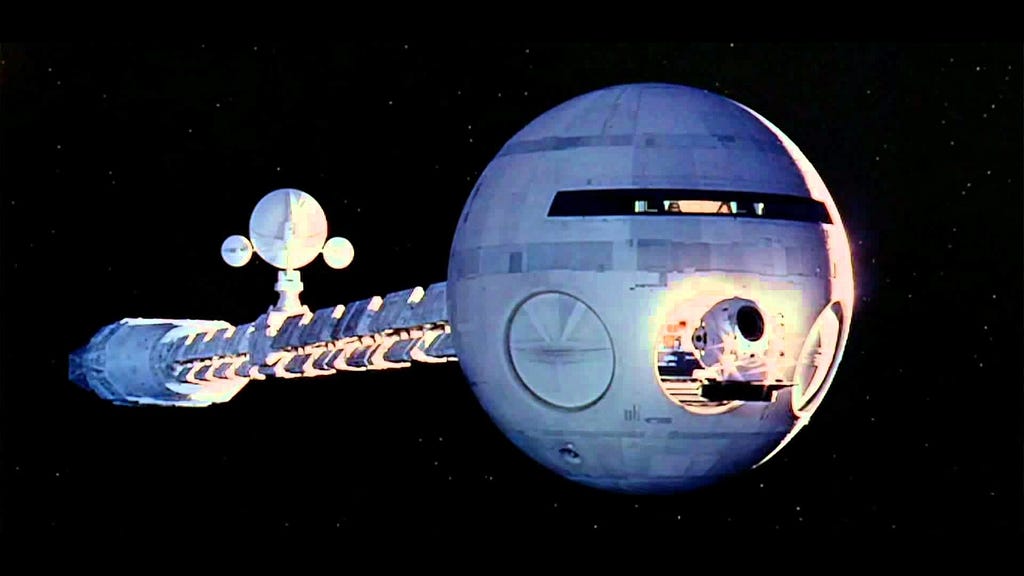 The Discovery from the movie 2001: A Space Odyssey (src: syfy wire)
The Discovery from the movie 2001: A Space Odyssey (src: syfy wire)
ACC predicted that it would be much easier to build large space-faring ships in orbit and to use shuttles to get astronauts up to the ships. This is how the Discovery was built in 2001: A Space Odyssey and its successors in the sequels as well. This wasn’t an ACC invention — many science fiction writers predicted this. Are we doing this today? Not exactly, but it’s within reach. There are companies who have sent up 3d printers to assemble large structures in space (Made in Space is the company that has printed the largest 3d printed object ever in preparation for printing large structures in space) , and there are near-term plans for inflatable modules which get assembled into large structures in space (think Bigelow Aerospace). Thus far, the ISS is the only such structure that is fully deployed, but this prediction is not very far off.
5. Hal and Conversational Artificial Intelligence.
Who can forget the classic line from 2001, which came from HAL 9000, the on-board artificially intelligent computer: “I’m sorry, Dave, I can’t do that?”
 I’m sorry Dave, I can’t Do that — the HAL 9000 computer from 2001 (src: wikipedia)
I’m sorry Dave, I can’t Do that — the HAL 9000 computer from 2001 (src: wikipedia)
There has been an artificial intelligence explosion in the last 10 years, as machine algorithms are now being used to learn to do everything from drive cars to play video games. ACC wasn’t the first to predict machine intelligence;
MIT Professor and Bell Labs fellow Claude Shannon was one of many who said that someday machines would be able to beat a human grand master at chess and write poetry. The chess thing has happened already, not so sure about the poetry. In the age of Sofia and so many different kinds of AI and virtual influencers and personalities, it seems like an intelligent computer like HAL from 2001, that can converse with us, is not that far off — give it 10 to 20 years say some experts.
6. Europa, liquid water, and life.
In the sequel to 2001, called 2010: Odyssey Two and its follow up 2061: Odyssey Three, Clarke scrapped Saturn’s moon Iapetus and made the books sequels to the movie, rather than to his novel. In this sequel, a crew of soviet and American astronauts went to Jupiter to find the Discovery and find out what happened to Dave Bowman and his crew, who had disappeared.
When they got there, one of the moons of Jupiter that is most interesting to them (and to the alien StarChild that Dave Bowman has now become) is Europa, which is found to be covered with ice with oceans underneath. The second book ends wiht a whopper: Jupiter is transformed into a small star and Europa is the reason why, because there is life that can develop here! In a now famous line from the end of 2010: All These Worlds Are Yours Except Europa. Attempt No Landings There.
In 2061, a crew actually goes to Europa, which has developed into a habitable planet thanks to Jupiter’s transformation at the end of 2010 into a small sun, called Lucifer from Earth. Leaving aside the super-intelligent aliens who were responsible for this, Clarke’s predictions about Europa being the most likely place for life in the solar system because of the presence of liquid water under the ice covering the planet has turned out to fairly accurate.
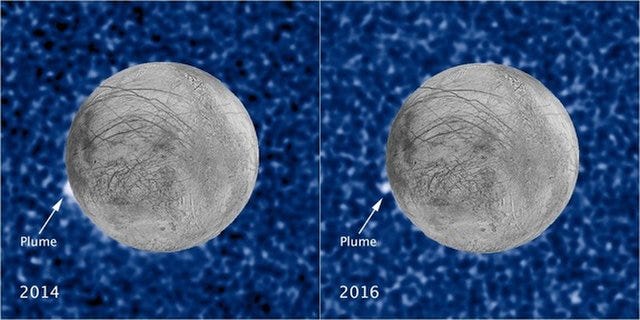 Plumes of water have been seen on Europa (src: Space.com)
Plumes of water have been seen on Europa (src: Space.com)
Probes to the Jovian moons have shown that Europa has plumes of water that shoot up from the surface, and it’s estimated that it has a covering of water 100 km thick. Some estimates say that Europa may have more water than the Earth!
Now, what might lie in wait in all that water under the ice? To quote the History Channel’s hit series, could it be … Aliens??
7. Landing on a Comet.
At the beginning of the novel 2061:Odyssey Three, published in 1987, in what I thought was a cool sequence, the spaceship Galaxy is landing on the surface of Halley’s comet which has returned to Earth in (do the Math and you’ll see why the novel was set in 2061!).
Of course, there’s a lot more going on in this novel than the comet, but at the time, this part, along with the rest of the novel was thought of as science fiction. Today, we know that it’s not so far fetched. In 2004, the European Space Agency launched Rosetta, a space probe that was meant to study a comet. Twelve years later, in 2016, the probe not only surveyed a comet, 7P/Churyumov–Gerasimenko, but it managed to hard land on the comet!
I wonder what we’ll be doing in 2061??
OK so there you have 7 predictions that have either already come true, or are very likely to in a decade or two. Not a bad track record. But, of course, science fiction being science fiction, there are still lots of things in ACC’s novels and papers for us to aspire to.
And those are just the ones that have or are likely to come true pretty soon! Wait until we talk about he Space Elevator (Fountains of Paradise), Diamonds in the heart of Gas Giants (2061: Odyssey Three), and interstellar colonization (Songs of Distant Earth), not to mention the tantalizing idea of artifacts hiding on the moon (if you were an ancient Alien visitor to the Earth, where would you put a communications device??).
If you liked this article, please clap 20x and follow me.
The 7 Space Predictions from Arthur C Clarke That Came True! was originally published in Hacker Noon on Medium, where people are continuing the conversation by highlighting and responding to this story.
Disclaimer
The views and opinions expressed in this article are solely those of the authors and do not reflect the views of Bitcoin Insider. Every investment and trading move involves risk - this is especially true for cryptocurrencies given their volatility. We strongly advise our readers to conduct their own research when making a decision.